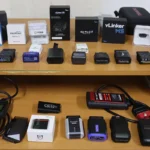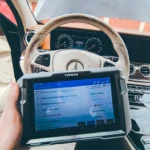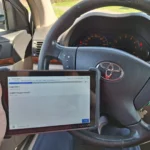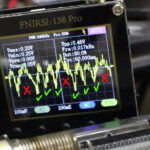The code P0032: Oxygen Sensor Heater Control Circuit High (Bank 1 Sensor 1) points out a fault in the oxygen sensor’s heater circuit, and most likely is caused by issues in the sensor itself, wiring, or the vehicle’s computer.
P0032 quick overview
| Meaning | P0032: Oxygen Sensor Heater Control Circuit High (Bank 1 Sensor 1) |
| Is it serious? | Yes, it can affect fuel efficiency, emissions, and overall engine performance. |
| Possible causes | – Faulty oxygen sensor (Bank 1 Sensor 1) – Damaged or corroded wiring or connectors for the oxygen sensor – Faulty fuel pump or low fuel pressure – Clogged fuel filter – Issues with the PCM or its grounding – Non-OEM replacement parts causing compatibility issues |
| How to diagnose? | Check the Oxygen Sensor: Inspect the oxygen sensor (Bank 1 Sensor 1) for any visible damage or wear. Inspect Wiring and Connectors: Examine the wiring and connectors associated with the oxygen sensor for any signs of damage, corrosion, or disconnection. Measure Fuel Pressure: Using a gauge, check the fuel pressure to ensure it’s within the specified range. Examine Fuel Components: Look into the fuel filter and fuel pump. Consider replacing the filter if the vehicle ran low on fuel or if pressure is low. Verify Gauge Accuracy: If using a gauge to measure fuel pressure, ensure its accuracy by cross-referencing with another gauge. Check Voltage at the Fuel Pump: Ensure the pump is receiving the correct voltage. Inspect Ground Connections: Ensure all ground connections, especially those related to the PCM and fuel system, are secure. Examine the Entire Fuel Supply System: Check the entire system for any faults, from the tank to the injectors. Use OEM Parts: If parts were replaced, ensure they are of OEM quality to avoid potential issues. Consult Technical Service Bulletins (TSBs): Sometimes, specific vehicle models may have known issues related to this code, and manufacturers might release TSBs with guidance. |
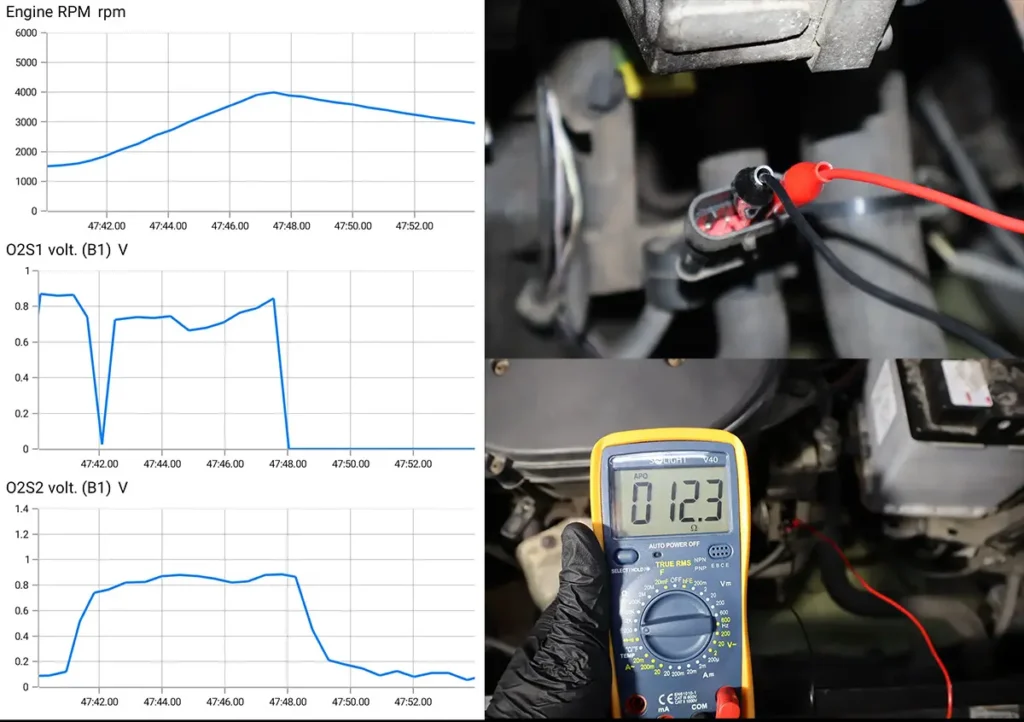
Test oxygen sensor PDF
- How to locate a specific sensor (bank1, 2)
- How to test with a multimeter
- How to test using an OBD-II reader
- Verify O2 sensor/CAT just with live data
Case study: How to fix P0032
I looked into P0032 service cases at iatn.com website where in the private forums the mechanics seek advice from other mechanics. I looked up a bunch of cases to help you decide how to fix your issue and see what would a real mechanic do to solve it.
Common fixes
| Fix | Frequency (%) |
|---|---|
| Replace O2 sensor with OEM part | 50% |
| PCM/ECM replacement | 30% |
| Repair or secure ground connections | 10% |
| Wiring harness inspection/repair | 10% |
Replacing O2 sensors with OEM parts was the most frequent and effective fix for P0032, resolving 50% of cases. PCM/ECM replacement was also common, especially when wiring or aftermarket sensor issues were ruled out.
Common mistakes
- Using Aftermarket Sensors: Mechanics often installed aftermarket O2 sensors, leading to persistent P0032 codes. OEM sensors resolved the issue in many cases.
- Overlooking Ground Connections: Ground wires were sometimes loose or poorly connected, particularly near the intake manifold. Failing to inspect and secure these caused recurring issues.
- Not Resetting PCM: Some mechanics neglected to reset the PCM after sensor replacement, causing old resistance values to linger and trigger repeated codes.
- Incorrect PCM Installation: Installing the wrong model year PCM, particularly on Dodge vehicles, caused circuit configuration mismatches that triggered P0032 codes.
- Missing Wiring Damage: Wiring damage or insulation rubbing against components was sometimes overlooked, leading to improper grounding or shorts in the heater circuit.
Key takeaways
- Use OEM Sensors: OEM sensors are specifically designed for the correct resistance and voltage. Aftermarket sensors often cause issues with the O2 heater circuit.
- Check Ground Connections: Inspect and secure all grounds, particularly near the intake manifold and PCM. Loose grounds frequently cause P0032 codes.
- Reset PCM: After replacing sensors, reset the PCM or disconnect the battery to clear old resistance values, which could otherwise trigger repeated codes.
- Inspect Wiring Thoroughly: Check the wiring harness for damage, exposed wires, or insulation rubbing against metal. Load testing the wiring can help detect faults.
- Ensure Correct PCM Compatibility: Install the correct PCM for the specific model year to avoid circuit configuration issues, especially on Dodge vehicles.
Case #1: Dodge
2006 Dodge Caravan 3.3L
Issue + Repair History: Vehicle initially came in with a P0032 code (O2 heater circuit voltage B1S1). An O2 sensor was replaced but the issue persisted. The vehicle returned with a P0138 code (O2 sensor voltage high B1S2). After replacing the sensor, the P0032 code appeared again. The technician performed tests and was considering a bad PCM.
Other OBD2 Codes + Test Results:
- P0032: O2 heater circuit 1/1
- P0138: O2 sensor voltage high B1S2
What People Suggested:
- There might be a software update for the codes on Caravans of that year.
- Before replacing the PCM, check the circuits, power at PCM, power at the sensor, and test the grounds.
- Check the wiring, especially the sensor return and signal.
- Perform an ohms test on the wiring to check for resistance.
- Consider using Denso brand O2 sensors as they might resolve the issue.
Final Fix: The vehicle returned with the same problem. The PCM was replaced and the issue was resolved.
Case #2: Chrysler
2004 Chrysler PT Cruiser GT 2.4L
Issue + Repair History: Vehicle initially showed faults for P0032 and P0038. O2 sensors were replaced. The vehicle returned with P0031 and P0037. After testing, the PCM was identified as the issue and replaced. However, the vehicle returned with multiple codes including P0032 and P0038. All signals, voltages, and grounds were rechecked. O2 sensors were replaced again, but the issue persisted.
Other OBD2 Codes + Test Results:
- P0032: O2 sensor heater B1S1 Circuit High
- P0038: O2 sensor heater B1S2 circuit High
- Voltage at sensor heater: 3-4v
- Ground circuit resistance: 2 Ohms (Spec is 5 per alldata)
- Duty Cycle at sensor: 25% (scan readout is 30% for test)
- Ground voltage drop of sensor: 170 mv
What People Suggested:
- Check for shorts to ground and high resistance if the voltage on the O2 sensor heater is 3-4 volts.
- Possible causes include faulty O2 sensors, open or shorted harness, poor electrical connection, faulty fuse, or a faulty ECM.
- Consider a wiring issue, especially on the ground side. Check G183 and S111 and the harness over the transmission.
- The heater circuit might be power side switched. Isolate the ground to the O2 heaters and load test it.
- The PCM might be activating the O2 sensor heater to 100%, but it will only ever command it to about 25%. Disconnect the PCM to erase the memory of O2 heater resistance values.
- Check the wiring harness with a load, using a halogen bulb.
- Examine the loom for any signs of insulation rubbing through.
Final Fix: After rechecking everything and running spare redundant grounds for the O2 sensors, it was determined that the issue was a defective PCM directly from Chrysler. After replacing the PCM again, the vehicle operated correctly.
Case #3: Cadillac
1994 Cadillac Eldorado 4.6L
Issue + Repair History: Vehicle experienced surges, stalling, and difficulty restarting. After a period of sitting, it would restart and run normally. A new map & computer had been previously installed at another shop.
Other OBD2 Codes + Test Results:
- P0032: Open map circuit
- P072: Intermittent map signal
What People Suggested:
- There were known issues with some PCMs in 1994. GM released a bulletin addressing these issues, suggesting that internal “noise” in some Northstar PCMs could induce into the internal PCM MAP circuit. The PCM was redesigned to correct this. If the PCM has the new service part number, inspect the MAP sensor connections and circuitry.
- There were also issues with the engine harness rubbing through on the edge of the transmission pan and battery cable corrosion inside the battery cables at the battery.
- Check the MAP signal wire at the PCM. If it feels spongy or rubbery when pulled, it might indicate a broken wire.
- Backprobe the map with a lab scope under various running conditions and with the ignition on and a vacuum pump. The signal might drop out only under specific conditions.
Final Fix: After scoping the map sensor (which had been replaced previously), it was found that the signal would go completely open. The map sensor was replaced for the second time, resolving the problem.
Case #4: Toyota
Vehicle Information 2004 Toyota Camry XLE 3.0L
Issue + Repair History MIL lamp on with code p0032: a/f ratio sensor heater control ckt high b1s1. Both a/f ratio sensors b1s1 and b2s1 were replaced. The code for b1s1 returns immediately after starting the engine. The PCM is not grounding the a/f ground properly during engine operation but does so when the engine is shut off. Manual grounding of the sensor shows a 3.7amp current, which is deemed normal. All tests were done at the PCM, and there’s a suspicion of a bad PCM.
Other OBD2 Codes + Test Results Code: p0032- a/f ratio sensor heater control ck. high b1 s1 Tests:
- Power checked and found good.
- Ground checked and found good.
What Are People Suggesting to Fix Issue
- Check all PCM grounds for voltage.
- Swap heater ground wires B1S1 and B2S1 to diagnose if it’s a PCM or wiring/sensor issue.
- Inspect PCM grounds on the intake manifold.
- Ensure sensors are OEM to avoid issues.
- Check power and ground to the sensor heater.
- There might be a TSB (Technical Service Bulletin) related to the issue: # eg009-05.
- Suspect the ECM might be at fault.
- Check freeze frame data and follow pinpoint tests for the heater circuit resistance and voltage checks at various connectors.
What Was the Final Fix The issue was due to loose grounds at the intake manifold. Two grounds were joint together and were loose. After fixing the ground connections, the issue was resolved.
Case #5: Subaru
Vehicle Information 2003 Subaru Baja 2.5L
Issue + Repair History Poor idle quality, hesitation, and MIL lamp on. The vehicle had low fuel pressure at 15 p.s.i. The fuel pump was replaced, but the fuel pressure remained the same.
Other OBD2 Codes + Test Results Code: P0032- B1s1 oxygen sensor Tests:
- Fuel pressure was 15 p.s.i even after replacing the fuel pump.
What Are People Suggesting to Fix Issue
- Check if the fuel pressure should be around 44psi and consider replacing the filter, especially if the vehicle ran low on fuel.
- Test the entire fuel supply system for faults.
- Confirm the gauge’s accuracy by trying a different gauge.
- Check the fuel pressure before the inline filter to determine if the source is a defective fuel pump.
- Ensure full voltage is reaching the pump and that grounds are good.
- Check the fuel pressure after the fuel filter, as it might be clogged.
- Use crimp off pliers to restrict the return line and see if the pressure increases. If not, check the voltage at the pump.
What Was the Final Fix Upon rechecking the fuel pressure before the fuel filter and finding it still low, the fuel pump assembly was removed for closer inspection. The fuel was entering the pump and into a type of cup with a metal cup. The o-ring seal was popping off because the metal cup clip was broken. After welding the cup clip back on, the problem was resolved.
Case #6: Dodge
Vehicle information: 2004 Dodge Caravan Sport 3.3L
Issue + repair history: The vehicle arrived with the MIL lamp on, showing code P0032 for the O2 sensor (Bank 1, Sensor 1) heater circuit issue. After testing at the connector on pin #2, no voltage was found for the heater on the brown/light green wire. Despite a new upstream O2 sensor being installed and road-tested as good, the code persisted. The technician couldn’t locate the wire at the PCM connectors.
Other codes + test results:
- P0032 – Bank 1 Sensor 1 heater circuit problem
Other mechanics suggestions:
- Check for a blown fuse or broken wire in the heater circuit.
- The heater voltage on Chrysler vehicles is controlled by the PCM, specifically at PCM connector C1, pin 18.
- Verify whether the sensor installed was an aftermarket part, as different resistances could trigger the MIL again.
- Perform continuity tests for power and ground wires and inspect for harness problems with Dodge Caravans, especially around pin 18.
Final fix: The problem was resolved by replacing the O2 sensor with a dealer (OEM) sensor. After the replacement, no further issues were reported, and the van was fixed.
Case #7: Chrysler
Vehicle information: 2004 Chrysler PT Cruiser Limited 2.4L
Issue + repair history: The vehicle randomly stalled after hot soak and failed to start again, setting codes P0032, P0038 (O2 sensor heater circuit high), P2302, and P2305 (ignition coil secondary circuit problems). The technician inspected and cleaned the O2 sensor heater ground, and sent the PCM to be rebuilt after knocking on the PCM case caused the vehicle to start. After the rebuild, the car stalled again with the same codes.
Other codes + test results:
- P0032 – Bank 1 Sensor 1 heater circuit high
- P0038 – Bank 1 Sensor 2 heater circuit high
- P2302 – Ignition coil 1 secondary circuit insufficient ionization
- P2305 – Ignition coil 2 secondary circuit insufficient ionization
Other mechanics suggestions:
- Ensure the original PCM was returned, as some rebuilders swap them, causing new issues.
- Check if data is lost when the car dies, and inspect power and grounds, especially near the crank sensor and O2 sensor behind the motor.
- Replacing ignition coils and using OEM plugs may resolve ionization codes.
- Heater circuit issues are often PCM-related. Test O2 heater circuit amperage at the PCM connector and check for missing grounds.
- The failing PCM could explain both heater circuit and ignition coil issues. Aftermarket rebuilds often fail, so consider a used PCM.
Final fix: No final fix was posted before the case was closed due to time expiration. However, recommendations strongly suggest replacing the PCM or coils with OEM or salvage parts due to recurring PCM issues.
Case #8: Dodge
Vehicle information: 2003 Dodge Ram 1500 Van 5.2L
Issue + repair history: The ECM was replaced to resolve issues with the IAT, ECT, and transmission sensors, but after the replacement, the vehicle began setting a P0032 code (O2 sensor heater circuit high for Bank 1, Sensor 1) on startup. The technician tested the wiring using a headlight to substitute the heater and found no issues. The technician suspected the ECM was faulty and sent it back to the rebuilder, but the second ECM had the same issue. It was later discovered that the replacement ECM was from the wrong model year (’02 instead of ’03), which had a different O2 heater circuit configuration.
Other codes + test results:
- P0032 – Bank 1 Sensor 1 heater circuit high
- Previous codes: IAT, ECT, transmission temp sensors, P1596, P1763 (resolved with original ECM replacement)
Other mechanics suggestions:
- Check ground continuity for the O2 sensor, as the PCM provides ground for the heater.
- Verify if the O2 sensor heaters are being activated individually or simultaneously to reduce load.
- Confirm the number of O2 sensors in the vehicle and check Solus datastream for discrepancies.
- Inspect the pins and wiring in the O2 sensor harness for damage or loose connections.
- Weak quad drivers in the ECM could be responsible for the issue, especially if the ECM cannot handle the circuit load.
Final fix: The issue was resolved after the technician discovered that the ECM provided was for a 2002 model, which had a different O2 heater circuit. The correct ECM for the 2003 model year was installed, which resolved the P0032 code.
Case #9: Toyota
Vehicle information: 2003 Toyota Camry LE 3.0L
Issue + repair history: The vehicle had MIL lamp on with instant codes P0032 and P0052 appearing within 15 seconds of clearing. Both O2 sensor heaters showed 3.8 ohms when cold, and battery voltage was present at the heater with the key on. However, when the harness was reconnected, the ground dropped to zero. A body shop had previously replaced spark plugs and damaged the rear oxygen sensor wires (3 out of 4 were exposed). The sensor was replaced with an OEM part, but the issue persisted.
Other codes + test results:
- P0032 – O2 heater circuit high (Bank 1, Sensor 1)
- P0052 – O2 heater circuit high (Bank 2, Sensor 1)
Other mechanics suggestions:
- Consider a TSB for air/fuel sensor problems.
- Verify if the PCM is shorting the B+ circuit internally, especially since the voltage dropped when the sensor was connected.
- Inspect the vehicle harness and perform a wiggle test to detect any hidden damage from the body shop’s previous repairs.
- Ohm test the wiring from the PCM to the sensors, checking for any issues in the harness or wiring damage elsewhere.
- Inspect the ground wire at the back of the intake manifold, as a loose ground could be responsible for both O2 sensor codes.
Final fix: The problem was caused by a loose ground wire behind the intake manifold, which was overlooked after the spark plug replacement. Tightening the ground resolved the issue, and the codes P0032 and P0052 were cleared.
Case #10: Chrysler
Vehicle information: 2004 Chrysler Town & Country Touring 3.8L
Issue + repair history: The vehicle initially came in with a P0135 code (Bank 1, Sensor 1 O2 sensor heater performance), and the O2 sensor was replaced due to an open heater circuit. After 200 miles, the vehicle returned with two new codes, P0032 (O2 Sensor 1/1 Heater Circuit High) and P0132 (O2 Sensor 1/1 Voltage High). The technician tested power, grounds, and wiring resistances, all of which checked out. However, the O2 sensor heater circuit was open again, and the sensor was replaced with the same NGK brand. The vehicle returned with the same codes after another 200 miles.
Other codes + test results:
- P0032 – O2 Sensor 1/1 Heater Circuit High
- P0132 – O2 Sensor 1/1 Voltage High
Other mechanics suggestions:
- Use only OEM Chrysler sensors, as aftermarket sensors (like NGK) often cause issues with the heater circuit.
- Chrysler vehicles are sensitive to O2 sensor heater circuits, and improper resistance from aftermarket sensors can lead to high voltage codes.
- Disconnect the battery or PCM after replacing the sensor to reset the PCM’s learned resistance values for the O2 sensor heater.
- Verify that the PCM is turning off the heater circuit and not causing the O2 sensor to overheat.
- Inspect for any potential wiring issues, including melted harnesses or shorts.
Final fix: The issue was resolved after installing an OEM O2 sensor. The NGK sensors had incompatible resistance, causing the P0032 and P0132 codes to persist. After switching to the OEM sensor, the codes did not return.

Test oxygen sensor PDF
- How to locate a specific sensor (bank1, 2)
- How to test with a multimeter
- How to test using an OBD-II reader
- Verify O2 sensor/CAT just with live data



